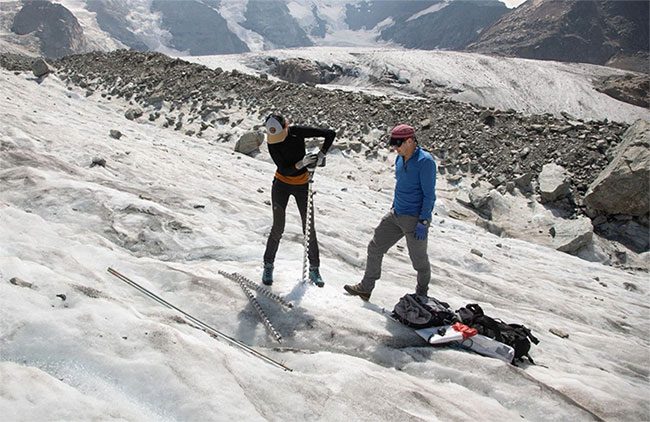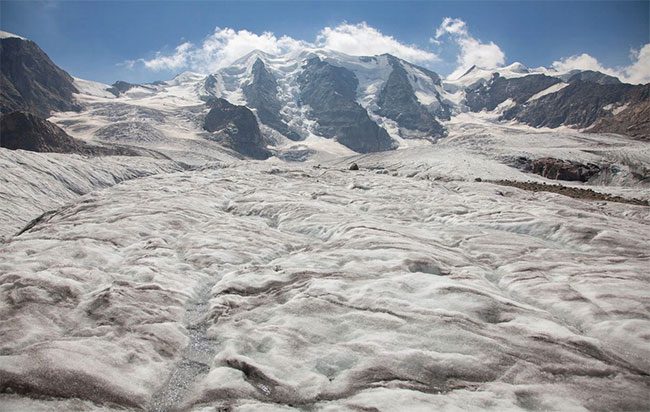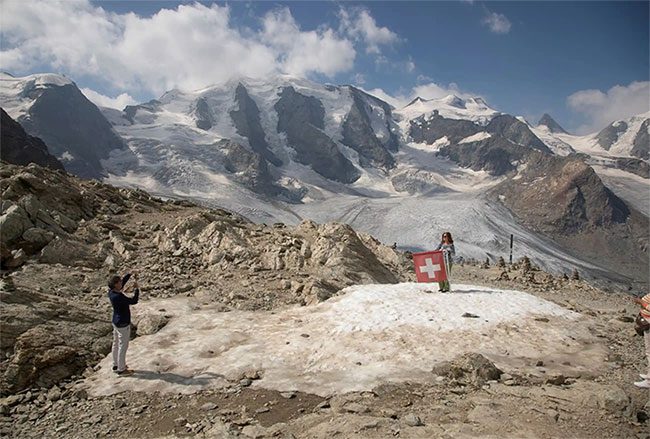Most glaciers around the world are gradually shrinking due to climate change, but this situation is particularly severe in the Alps, often referred to as the roof of Europe.
Andreas Linsbauer is a glaciologist. His job involves traveling to remote areas of the Swiss Alps to collect data on the changes occurring in this frigid landscape.
At 45 years old, Linsbauer glides effortlessly over the snow-covered ground with a 10 kg backpack on his back. Inside this backpack is all the equipment he needs for his work: mapping the decline of Switzerland’s glaciers.

Glaciologist Andreas Linsbauer and assistant Andrea Millhaeusler drill a hole at a measurement point on the Pers Glacier, near the Alpine resort of Pontresina, Switzerland. (Photo: Reuters).
A Harsh Summer
Typically, this researcher would be at the massive Morteratsch Glacier by the end of September each year, marking the end of the summer melting season in the Alps. However, this year, the ice loss has been unusually large, and Linsbauer had to arrive nearly two months earlier than scheduled to conduct urgent measurements.
The poles Linsbauer usually uses to measure the depth of the ice are beginning to wobble due to excessive melting, forcing him to drill holes to install new poles.
Exclusive data shared with Reuters indicates that the glaciers in the Alps are shrinking at the highest rate seen in the past 60 years. By comparing the difference between snowfall in winter and ice melt in summer, scientists can estimate the rate of glacier decline in a given year.
Last winter in the Alps saw very little snowfall, while this summer has experienced two heatwaves. Temperatures recorded in the village of Zermatt in the Swiss Alps reached nearly 30 degrees Celsius last July.
During this heatwave, the altitude at which water freezes reached a record 5,184 meters – higher than the peak of Mont Blanc, the highest mountain in the Alps. Normally, summer freezing temperatures in this mountain range cover areas from 3,000 to 3,500 meters.
“This is clearly a harsh summer,” Linsbauer said, nearly shouting over the noise of streams formed from melting glacier water.
Most glaciers worldwide – remnants of the last Ice Age – are gradually disappearing due to climate change. However, the glaciers in the Alps are particularly vulnerable because they are smaller in size and only covered by a relatively thin layer of ice. Meanwhile, temperatures in the Alps are warming at an average rate of 0.3 degrees Celsius per decade, twice the global average.
If greenhouse gas emissions continue to rise, the glaciers in the Alps could lose more than 80% of their mass by the end of this century. According to a 2019 report from the Intergovernmental Panel on Climate Change (IPCC), this trend is irreversible, and many glaciers in the Alps will disappear even if we take immediate action.
Morteratsch – a favorite destination for tourists in the Alps – has now changed and is no longer the glacier of yesterday. The white ribbon that once stretched from the mountain peak down to the valley below has shortened by about 3 kilometers, while the thickness of the snow and ice has decreased by up to 200 meters.

The Pers Glacier, which once connected to the Morteratsch Glacier, has now receded and no longer flows into Morteratsch. (Photo: Reuters).
The grim situation this summer has raised concerns that the glaciers in the Alps may disappear sooner than expected. According to Matthias Huss, head of the GLAMOS organization monitoring glaciers in Switzerland, this is entirely possible if the weather in the coming years mirrors what happened in 2022.
“We are seeing predictions for what will happen in the coming decades occurring right now. I don’t think we will see a year as harsh as this since the beginning of the century,” Huss added.
The Glaciers of the Alps Will Become History
Glaciologists in Austria, France, and Italy confirm that the glaciers in these countries are shrinking at record rates. In Austria, glaciers are no longer covered by snow, according to Andrea Fischer, a glaciologist at the Austrian Science Institute.
Annual snowfall not only replenishes the ice lost during the summer but also protects the glaciers. The layer of snow acts as a natural white cover, reflecting sunlight and helping to reduce melting. This white snow layer reflects light better than ice, as glaciers often mix with dirt and other pollutants.
This has led to some famous ski resorts in Switzerland using large white tarps to protect the snowpack from summer sunlight.
The glaciers of Switzerland appear in many fairy tales, and their mystique can be considered part of national pride. The Aletsch Glacier in Switzerland is even recognized by UNESCO as a World Heritage Site.
At the Grand Etret Glacier in northwestern Italy, this year snowfall was only 1.3 meters thick, significantly lower than the average of 2 meters recorded over the past 20 years.
The significant reduction in ice cover in the Alps this year has surprised even scientists. Many glaciers have shrunk in recent years, existing only in high-altitude areas where temperatures are lower, theoretically offering better protection.
“You can easily imagine what will happen at the end of summer, which is a widespread reduction in glacier coverage in the Italian Alps,” said Marco Giardino, vice president of the Italian Glaciology Research Committee.
The unprecedented melting rate of the glaciers in the Alps also brings new issues. Part of the natural border between Italy and Switzerland lies on the thick glacier atop the Alps.
As these glaciers melt, it means that the terrain is changing, and the natural border between the two countries is becoming less fixed.

A woman taking a photo with the Swiss flag near the peak of Piz Palü. (Photo: Reuters).
This is a shared issue, leading Italy to sign agreements with Austria and Switzerland in 2006 and 2009, respectively, to recognize the border in the Alps as a “mobile” border, meaning it can change beyond the control of nations.
A rare case occurred when Rifugio Guide del Cervino, a famous Italian restaurant located near the border, built in 1984 on Italian territory, suddenly found itself on Swiss land.
The thinning ice in the Alps is also gradually revealing the remains of missing persons from the past, as well as a plane crash from 1968.
Two French climbers discovered human remains on August 3 while exploring the Chessjen Glacier in the Valais region of Switzerland, confirmed by police on August 8.
Dario Andenmatten, manager of the Britannia Hut in the Alps, believes the person may have died around the 1970s or 1980s.
Just a week earlier, another set of remains was discovered at the Stockji Glacier near the Matterhorn resort in Zermatt.
Police are analyzing the DNA of both sets of remains.
Authorities in the Alps have a list of about 300 missing persons since 1925.
German media suggests that the remains found at the Stockji Glacier belong to billionaire Karl-Erivan Haub, who went missing while skiing in April 2018 and was declared dead in 2021.
However, the climber who found the remains stated that they discovered neon-colored clothing “in the style of the 1980s.”
Earlier in August, mountaineer Dominik Nellen discovered wreckage from a plane identified as having crashed in 1968.


















































